#blake snyder beat sheet
Explore tagged Tumblr posts
Text
The children yearn for the mines thing but it's just me, yearning for a literary analysis assignment after finishing a book.
So because i have a Film degree, i did the Blake Snyder beat sheet for this novel lol
my Jane Eyre beat sheet
Opening Image - Jane's abusive childhood
Set-Up - Jane is desperate for love and acceptance, desperate to find family and a home where she will feel appreciated.
Theme Stated - Forgiveness is important in love.
Catalyst - Jane is sent to the super religious school where she learns to double down on her people pleasing instincts. Maybe someone will love her and accept her if she is obedient and useful and selfless– this school and its teachings snuff out her sense of self-worth.
Debate - Jane reveals that she wants her abusers to suffer. Helen tells Jane about god and how crucial forgiveness is, even for those who wrong you.
Break Into Two - Jane takes her future into her own hands, taking out an advertisement and goes to work at Thornfield. She can be useful and find purpose in caring for others.
B Story - Jane meets Rochester– who is not attractive or kind, so it puts her at ease. He puts no effort into being "good" and does not claim or aspire to any virtues her teachings were based on, which is refreshing. He values what she has to say, appreciates her gifts and overall personality, and makes her feel like she is actually worthy of attention.
Fun and Games - As Jane and Rochester develop a rapport, she begins to feel important and useful, and takes pleasure in being of service to him. Even though she worries that he is in love with Blanche Ingram, he proposes to her. She realizes that he appreciates her for who she is because she is worthy of love. She does not have to fade into the background as she was taught.
Midpoint - Rochester is not only already married, he keeps his wife locked in the attic.
Bad Guys Close In - Jane is determined to respect Rochester’s marriage, even at the cost of her own happiness. He loves and accepts her as she is (yay!) but she cannot forgive him for breaking his marriage vow (boo!). Her want/goal was to find people who loved her as she was. Her need is to learn to forgive people so she can be receptive to and reciprocate that love.
All Is Lost - Jane leaves Thornfield Hall. She rejects Rochester’s love, rejects her job, her home– everything she found and cultivated in this new life she made for herself and winds up starving and cold and penniless and alone. Worse off than when she left the Reed’s house or the school in the beginning.
Dark Night Of The Soul - The Rivers take Jane in and give her a new family to belong to, a new vocation, a chance to live independently, but without the kind of love she had from Rochester. St. John proposes marriage for the purpose of making her a missionary’s wife. It will be a platonic marriage, at the service of god, where she will have to be selfless and deny her own personal desires. This is the opposite of the life she was leading at Thornfield Hall where her opinion was valued and her appetite for love was well-fed, and her weird little delights in being called an elf and endearingly teased were satisfied. She will not get that as a missionary’s wife, where the emphasis will be on piety and goodness. St. John appreciates her, not for who she is, but for what he can make her. She hears Rochester crying out for her in the night and knows she has to go back to him.
Break Into Three - Jane returns to Thornfield to find it has been burned to the ground and Rochester is badly injured. He is free to marryy her now, he even needs her help so she will definitely be useful if she stays. She has to forgive him if she wants to be with him now. And if she wants to be with him now, she needs to reject being a people pleaser and marrying St. John to live as a selfless missionary’s wife; she knows her worth now. She will not sacrifice her happiness, she wants Rochester and she will have him.
Closing Image - Jane and Rochester live happily together. They have children. She loves her life. She feels useful and loved and does not have to sacrifice anything to be this content. Additionally, St. John is doing his missionary work and never marries– the epitome of the selfless, people pleasing life she was bound for if she had never learned her worth or how to value herself as she is, which is what Rochester’s love has given her.
#i wrote out this beat sheet just so i can write my ouat fic#blake snyder beat sheet#jane eyre#literary analysis#charlotte brontë#liveblog of me reading#long post
10 notes
·
View notes
Text
Writing Notes: Plot Method
The Save the Cat! Beat Sheet was originally developed by Blake Snyder to help screenwriters plot movies, but it works just as well with novels.
It breaks down the 3-act structure into small, specific sections (sometimes just one scene long).
Each section pushes your story forward in its own way.
The exact word count/page count of each section depends on how long your novel is and what type of story you’re telling, but you can use the colored chart below and the percentages in the instructions as a guide.
Context Note: This method is based on the concept of the Three Act Structure, which is an inherently Western approach to plot. It can be a useful way to tell a story, but it is by no means the only one.

ACT 1
Opening Image (0-1%)
Show a “before” snapshot of your protagonist and their world.
What is life like before the adventure begins?
It represents the struggle & tone of the story.
Set-up (1-10%)
Expand on the “before” snapshot.
Explore your protagonist’s life, including the internal flaws and external challenges they’ll have to overcome in order to change for the better by the end of the story.
Present the main character’s world as it is, and what is missing in their life.
Also introduce important supporting characters.
Theme Stated (happens during the Set-up)
What your story is about; the message, the truth.
Usually, it is spoken to the main character or in their presence, but they don’t understand the truth/lesson…not until later, when they have some personal experience and context to support it.
Thus, include a scene where a character says something that hints at what the protagonist’s big life lesson will be - how they’ll have to change and grow by the end of the story.
Catalyst (10%)
The moment where life as it is changes.
Examples: It is the telegram, the act of catching your loved-one cheating, allowing a monster onboard the ship, meeting the true love of your life, etc.
There’s no going back to the “before” world from here… What is the inciting incident that pushes the protagonist into the next phase of the story?
Debate (11-20%)
But change is scary and for a moment, or a brief number of moments, the main character doubts the journey they must take.
Show the protagonist questioning themselves and resisting the path ahead - wondering whether they have what it takes, or whether or they should just run home and hide under the bed.
“Should I just…?” “I really shouldn’t because…” “But what about…” Can I face this challenge? Do I have what it takes? Should I go at all?
It is the last chance for the hero to chicken out.
ACT 2
Break Into 2 (20%; Choosing Act Two)
The main character makes a choice and the journey begins.
We leave the “Thesis” world and enter the upside-down, opposite world of Act 2.
They make the choice to begin their adventure/transformation/journey/new thing.
Show your protagonist deciding to plunge into Act 2.
The Promise of the Premise (21-50%)
This is when the reader thinks “Ah, now we’re getting to the good stuff they hinted at on the back cover of this book!”
It’s also one of the longest sections in your book.
Show your protagonist getting used to their new world - loving it, hating it, making mistakes or doing well, meeting new people (see more below) and keeping the reader entertained.
This is when the main character explores the new world and the audience is entertained by the premise they have been promised.
B Story (happens during The Promise of the Premise)
This is when there’s a discussion about the Theme – the nugget of truth.
Usually, this discussion is between the main character and the love interest.
So, the B Story is usually called the “love story”.
Introduce a new character or characters who will eventually help the protagonist learn their life lesson.
Friends? Mentors? Love interests? Nemeses (nemesi?)? Who are they? How will they help?
Midpoint (50%)
This moment is when everything seems “great” or everything seems “awful,” depending on your story.
The main character either gets everything they think they want (“great”) or doesn’t get what they think they want at all (“awful”).
Either the Fun and Games section has lead to a false victory for your protagonist (they think they’ve been doing great so far) or a false defeat (they’ve been having a hard time so far).
What happens in this moment, halfway between beginning and end?
But not everything we think we want is what we actually need in the end.
Bad Guys Close In (51-75%)
Get ready for a bumpy ride. If your Midpoint was a false victory, now things start to go wrong for your protagonist.
If the Midpoint was a false defeat, well, things seem to be looking up, but the bad guys are getting closer and will have something to say.
Note: Bad guys can be actual physical enemies, but they can also be emotional enemies, like doubt or jealousy or fear.
Doubt, jealousy, fear, foes both physical and emotional regroup to defeat the main character’s goal, and the main character’s “great”/“awful” situation disintegrates.
Show the protagonist’s newly-built world beginning to unravel.
This will also be one of the longer sections in your novel.
All is Lost (75%)
This is when something happens to make your character hit rock bottom.
It’s the absolute lowest part of your novel.
Maybe someone or something dies (either literally or figuratively).
The initial goal now looks even more impossible than before. And here, something or someone dies.
It can be physical or emotional, but the death of something old makes way for something new to be born.
What does this moment look like for your protagonist?
Dark Night of the Soul (76-80%)
Your protagonist now has time to react to their “All is lost” moment, to mourn what they lost and wallow in hopelessness.
They’re worse off than they were at the beginning of the novel.
Show how low things have gotten.
Mourning the loss of what has “died” – the dream, the goal, the mentor character, the love of your life, etc.
But, you must fall completely before you can pick yourself back up and try again.
ACT 3
Break Into 3 (80%; Choosing Act Three)
The “aha!” moment; the “lift yourself up and try again” moment.
Show the protagonist realizing what they need to do in order to tackle their problems, both external and internal.
Thanks to a fresh idea, new inspiration, or last-minute Thematic advice from the B Story (usually the love interest), the main character chooses to try again.
Finale (81-99%)
The protagonist does what they decided to do in the Break Intro 3 beat, and (because of all the learning/growing they’ve done and the support or insight from the B Story), their plan works.
This time around, the main character incorporates the Theme – the nugget of truth that now makes sense to them – into their fight for the goal because they have experience from the A Story and context from the B Story.
The Bad Guys are defeated, the world is changed for the better.
What are the battles? How will the protagonist triumph (or not)?
This is another longer section, so you’ve got the space to make things dramatic and intense.
Act Three is about Synthesis.
Final Image (99-100%)
This is the opposite of the Opening Image, the “after” snapshot instead of the “before.”
Show the reader how the protagonist and their world have changed.
THE END
Sources: 1 2 ⚜ Writing Notes & References
#writing notes#plot#writeblr#fiction#on writing#writing tips#writing advice#writers on tumblr#dark academia#spilled ink#writing reference#literature#writing prompt#poetry#poets on tumblr#creative writing#writing inspiration#writing ideas#writing inspo#light academia#studyblr#writing resources
659 notes
·
View notes
Note
I remember back in school that they taught us how to write stories like a picture that looked like steps or a triangle where it would show the conflict, rising action, falling action, climax, etc. etc. So I wondered if you have found those methods to be effective or is there another way about it that you'd recommend?
Basic Story Structure
What you're talking about is very basic story structure, like this:
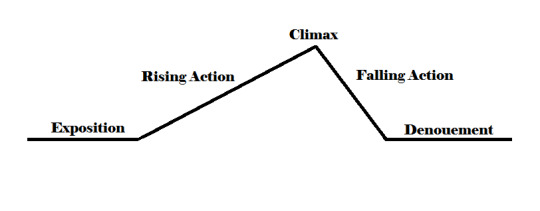
While this is certainly an effective way to understand how stories work at the simplest level, it's not great for showing all the plot points that happen in each of those sections.
If you're interested in a more in-depth story structure method or template, you can Google ones like Save the Cat Writes a Novel! to Larry Brooks Story Structure, Three-Act Story Structure, the Snowflake Method, The Hero's Journey, Blake Snyder's Beat Sheet, Derek Murphy's 24 Chapter Outline, Gwen Hayes' Romancing the Beat, Shawn Coyne's Story Grid, The Seven Point Plot Structure, Dan Harmon's Story Circle, The Five-Act Structure, James Scott Bell's A Disturbance and Two Doorways, Kishōtenketsu Structure, Story Spine.
The key with any story structure method or template is to know you don't have to follow them exactly. They're just a suggestion... like a suggested travel itinerary. You can follow it or you can augment it and work in some of your own stops along the way.
For more, head over to my Plot & Story Structure master list. :)
•••••••••••••••••••••••••••••••••
I’ve been writing seriously for over 30 years and love to share what I’ve learned. Have a writing question? My inbox is always open!
♦ Questions that violate my ask policies will be deleted! ♦ Please see my master list of top posts before asking ♦ Learn more about WQA here
121 notes
·
View notes
Text
what's the plan? outline methods & tips!
Hey, Rough Drafters!
This is for all the outline fans out there. Here are some tips on different outline structures that might help you while you blueprint your Rough Draft! I hope there is something helpful here whether you are new to outlining or a veteran. This is not a comprehensive list. I totally recommend digging into other narrative structures, seeing how they tick, and deciding what works for you!
✏️ The Hero’s Journey • Created by Joseph Campbell (using the simplified terms from Christopher Vogler)
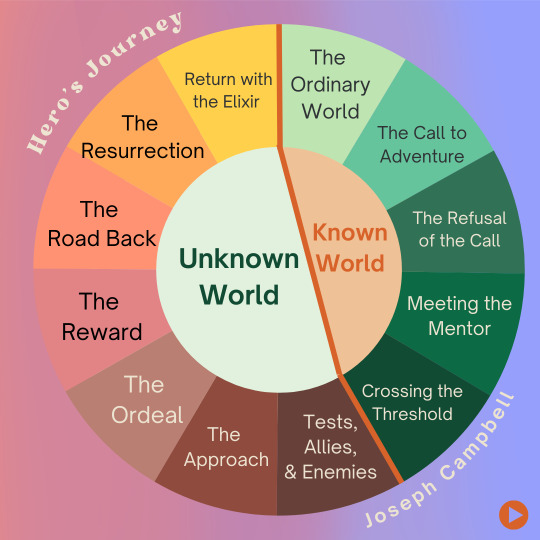
The Hero’s journey is the backbone of most outline structures. The only difficult thing is a lot of these terms are still derived from classic mythic structure and are less applicable today. However, since it has been so well dissected and discussed, there are so many resources to help transpose the terms to narratives that involve less sword-and-shield-heroism. It might take a little time to understand each beat and what it can mean for you and your story, but this is such a well loved structure and will give your story some solid backbone! This structure is best suited for an adventure story where characters travel from one place to another, but you can get creative about what that adventure or journey looks like. At its most basic, though, the hero’s journey will help take your characters on quests in a far off place—whether it’s in the stars, across the continent, or in a world of your own making.
⭐ Great media examples of ‘journey’ narratives are: Star Wars (pick one really), Little Miss Sunshine, Lord of the Rings, and Life of Pi.
✏️ Save the Cat • Created by Blake Snyder
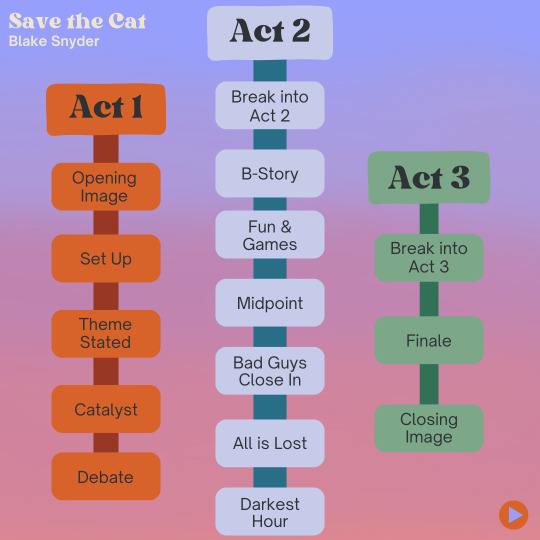
Save the Cat was originally intended for screenwriting. Its best application is in scripting, whether that be screenwriting, plays, games, or comics. The first and last beats help to set a tone for your story, which is crucial for script writing and opening/ending shots in films, but this concept can be just as important in prose. Consider using guidelines from this structure to plan your first and last scenes before you get to November.
⭐ You will recognize Save the Cat in most films, and you can find beat sheets to match films for example on the Save the Cat website.
✏️ Six Stage Outline by Michael Hauge
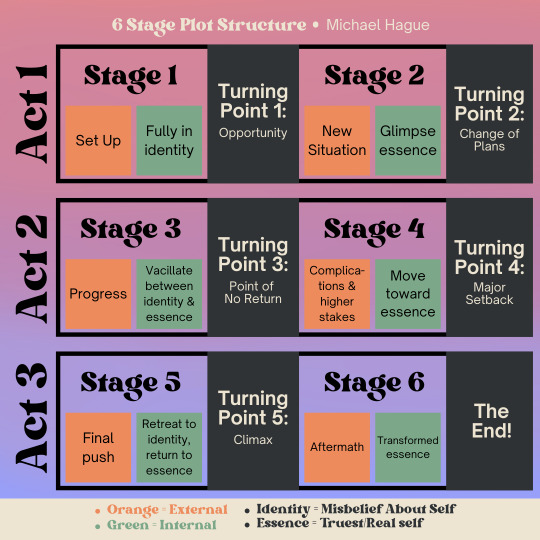
This structure is great to keep simple with bullet points or expand for more depth. In this outline there are only 11 beats—6 stages and 5 turning points. Turning points are the highest moment of external conflict. Ideally, internal and external conflict escalate at each turning point. Identity deals with character’s misbeliefs about themselves as the narrative drives them to be their most authentic self. This outline focuses on developing both internal and external struggles. If your story is particularly character-driven, this structure might be the one for you.
⭐ Many stories follow this structure but the one I was taught off of is the greatest movie of all time. Shrek.
Try drawing your arc with notes out on paper. This arc can silly: include dead ends, drop offs, spirals, tangles, anything! This helps visualize the ups and downs of the narrative. Also great to do after you’ve completed outlining for a visual aid.
Sometimes... one outline model is not enough! Mix and match your favorite terms and structures in the manner you feel best assists your narrative structure. Don’t be afraid to make it your own!
Read in your medium (novels, scripts, poems, etc.) and notate pages and scenes where the major beats happen. This really helps engage your brain and makes you more familiar with plot structure!
My favorite method to outline is the MLA outline structure. Using a template like this helps me put all of my ideas into place. I don’t have an excuse for not knowing what to do. This helps lock me in!
✏️ Uh oh, Secret Plantser Agenda!
If outlining the ending first doesn’t work for you, outline everything EXCEPT the ending! Leave something for you to discover once you get there!
Sometimes you need to take a step back. Maybe don’t make a 10 page outline. Maybe make 10 bullet points. Outline as much or as little as you need to.
Occasionally overplanning can cause me to lose the joy in my writing! Make sure to really experiment to find what works best with you and your style! Sometimes that means... making a less in-depth outline. This is a call out post for me (Sarah with an ‘h’) specifically.
✏️ Technically, I like to combine elements of all three of these plot structures, but Michael Hauge’s 6 stage outline is my favorite. It’s a very good structure for adjusting to your outlining style, whether you want to do just the bare bones plot points, or you want to use them as the waypoints as you plot out scene by scene. I like to use the stages and turning points as the headings and subheadings to my outline. I hope these tips are able to help you in your outlining journey, both planner and plantser alike. If you know of any other helpful tips for outlining, please share them with us!
Thanks for tuning in, happy drafting!
-Sarah with an ‘H’
#creative writing#writeblr#writers#writing#writing challenge#writing community#artists on tumblr#books#fanfic#rdmo24#rdmo#rough draft 2024#rough draft month#rough draft#writers on tumblr#nano alternatives#nanowrimo alternatives#nanowrimo
23 notes
·
View notes
Text
Chapter 4 of Save the Cat! was the one that I was most looking forward to: the Blake Snyder Beat Sheet and some discussions on story structure.
Maybe because he's a hack writer, or maybe because he's writing specifically with the intent to sell mass market movie scripts, he goes very structured. The Blake Snyder Beat Sheet is basically what this chapter is about, and when he's describing it, he's very firm about where each individual beat will be. A screenplay of the kind he's describing is 110 pages, and by God you better have the Catalyst exactly on page 12.
Going in, I was curious about two things. First, I'm very familiar with both Joseph Campbell's monomyth and Dan Harmon's story circle, so I was curious how easy the mapping would be, or whether there were any notable deviations in terms of what he suggests.
The BS2 is extremely similar to the monomyth. Of course, the monomyth was meant as observation, and the BS2 is meant as rules to follow for making a good story (or one that will sell), but many of the steps are identical. Snyder calls it the "Catalyst", Campbell calls it the "Call to Adventure". Snyder calls it "The Debate", Campbell calls it "Refusal of the Call". Interesting, Campbell said that refusal of the call was optional (since it didn't show up in all stories across all cultures) but Snyder insists on it.
Snyder doesn't call it the underworld, but he does repeatedly reference the "fun house" or "upside down" aspects of the middle part of the story, the antithesis to the setup's thesis. But here there's a break from Campbell, because for Snyder this is where we have the B-story, a plot that's contained within what Campbell would call the "underworld", which I found conceptually interesting, and which I could immediately map to a lot of stories and movies.
So there wasn't a lot new for me on that front. Opening, catalyst, underworld, enemies close in, triumph, synthesis ... it's not revelatory, and Dan Harmon does a better job explaining the fundamentals of why each piece is there, which helps if you ever want to monkey with them. I specifically found the "underworld B-story" bit interesting, and the phrase "promise of the premise" tickled something in me, but that was it.
Snyder's "promise of the premise" happens during a section he calls "Fun and Games", which happens in the second act, usually before the midpoint. It's the place where the characters are just having fun, where the plot isn't racing forward, where we're seeing all the stuff that's cool and awesome about our premise. I could immediately picture this in my head, and so far as I know, this isn't part of Campbell nor mentioned by Harmon (though it's been a bit). This is "the gang's all together and having fun", it's most of the stuff you'd put in the trailer, and yeah, I think conceptually this is a really strong narrative beat, and a valuable addition to my arsenal of storytelling concepts.
So second, I don't write screenplays, I write webfic that's ideally written in such a way that it becomes ebooks to sell on Amazon, and so I generally have some sense of what I'm doing in terms of structure, but wanted to see if these screenplay lessons had any mapability to the stuff that I do.
And overall ... kind of? Dan Harmon has this insight from TV work that the whole season of television is a big ol' monomyth circle, and each episode is a circle, and each bit of television between the ads is a circle, and you can just nest circles like that.
So my first step would be to say "fuck it" to this stupidly rigid structure, then to duplicate it across different spans of writing, and maybe make sure that I'm not missing anything that way. I think this would be fine, though mostly what I care about are the fundamentals, making sure that there is an underworld, that there is a synthesis, and that we do get some kind of climactic battle where the thematically appropriate forces of darkness seem like they might win. And then subvert a lot of that, because that's more interesting than playing it straight, and eventually playing it straight becomes so cliche that it just won't hit.
I generally do book-level plotting similar to story circle, though I'm not consistent in my approach, sometimes to my detriment. Understanding Snyder's method is helpful in the sense that it reinforces my understanding of what's important to have, what plot beats are most vital for having pleasing structure ... but I actually think that's maybe it?
I really do dislike the dogmatic approach, and really would have loved an exploration of movies that deviate hard from this approach and what makes those work. But Blake Snyder doesn't do that, and maybe is incapable of that level of analysis.
At this point in the book I'm thinking that he's a guy who can only build a single type of bicycle. He understands that bicycle really well, but not the actual mechanics of bicycles generally, so if you showed him a tandem bike or a recumbent he'd just scoff and say that it doesn't work in spite of clear evidence that it does.
19 notes
·
View notes
Text
Hehehehehe Blake Snyder's beat sheet (from Save The Cat) but make it an Alex Rider s4 based on Snakehead that I'm doing for fun because I want to prove to myself that I can
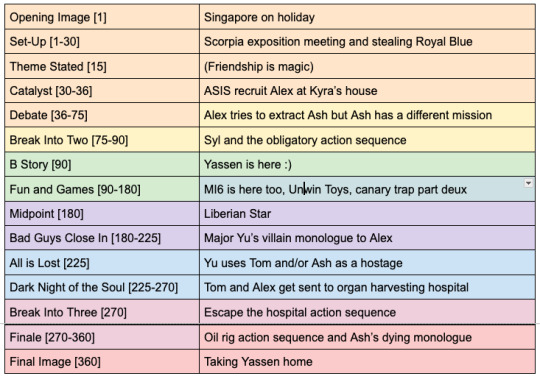
The timestamps are extremely approximate. Just kinda multiplied the times on the beat sheet by 3 and rounded to the nearest 45 minutes where appropriate. 8 ep x 45 min = 360 min (6 hrs)
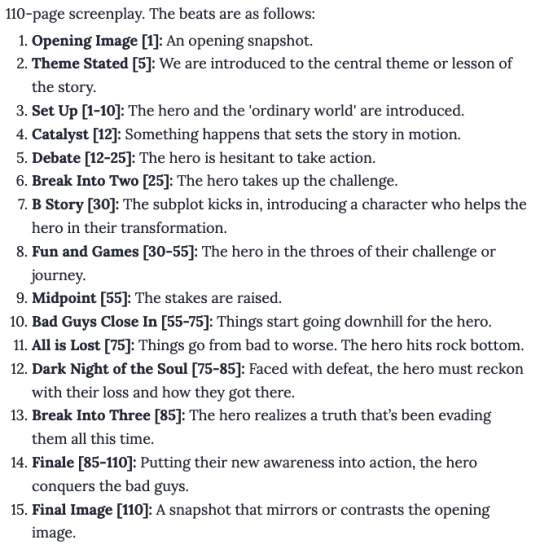
#Alex Rider TV#Alex Rider - Snakehead#Snakehead spoilers#Alex Rider#Yassen Gregorovich#Kyra Vashenko-Chao#Tom Harris#not my first beat sheet rodeo#obviously I'm not adapting the brown face or the ableism#Kyra's finally gonna find out who killed her parents (it was Ash)#there was a dangling theme in s3 about weapons not being able to go home and I'm picking it up and eating it#I love how much Yassen haunts the narrative in Snakehead#more even than John Rider#Ash is the stinkiest of men#I'm so excited to write him#Yeah that's right Tom is finally gonna get an action sequence!!#My favorite part of writing: math
14 notes
·
View notes
Text
Kagurabachi's Popularity: Familiarity Through Structure
Having a degree in writing and media is so fun because I can write an essay on why Kagurabachi can be defined as well written through craft standards and attribute its popularity overseas to its structure, which is framed similarly to western movies.
And I am!
After this interview confirmed that Takeru Hokazono, author of Kagurabachi, is a huge fan of western films, I went back to this idea I was playing with in October when KB had less than ten chapters. I had been reading since day one, and I knew it was good, and other overseas fan knew it was good. But what made it so good to us, overseas?
I made a quick thread on it on my Twitter account (that I never posted) where I mentioned Blake Snyder's Save the Cat book on script writing and story structure. I also brought up characterization and how it would've been really popular in my comic book class from undergrad. This thread discussed both Chihiro and Sojo, and the quick yet steady pace of the manga has given us more characters and moments to pinpoint. To not overwhelm myself, I'm not going to discuss the craft of characterization (maybe another time), and I'm not going to do a beat sheet for Sojo. For now, I'll try to stay under the first arc to map out why Kagurabachi has so far moved like a high budget film in manga form. So, spoilers ahead!
A quick lesson on Save the Cat, its three main characteristics are: Three act structure Fifteen plot beats Mostly applied to American Hollywood films
One of the biggest things I noticed right away was the resemblance a lot of the chapters, even the story as a whole, had to Snyder's beat sheet. This beat sheet that comes from Snyder's book is somewhat of an industry standard, so a lot of movies, even those that preceded Snyder, go through this structure of Act 1, 2, and 3. Snyder just identified the parts and broke them down to fifteen beats. Plus he dubbed the save the cat moment:
A decisive moment in which a protagonist demonstrates they are worth rooting for. Having the protagonist save a cat can be literal or figurative.
This was something KB needed and did have to have us warm up to Chihiro who post time skip, just gave gloomy orphan energy in the previous chapters. Here, Char would be our cat. Chihiro chose to save Char and chose to protect her, and continued to fight for her until she was rescued. He made this choice even before it's revealed that Char's mother died for her, something that would parallel Chihiro. This is what got readers to see him three dimensionally after being introduced to him. He's still the caring little 14 year old we saw at the start, who continues to take care of the innocent despite the tragedy he's been through. It is only natural for us to care for him, too.
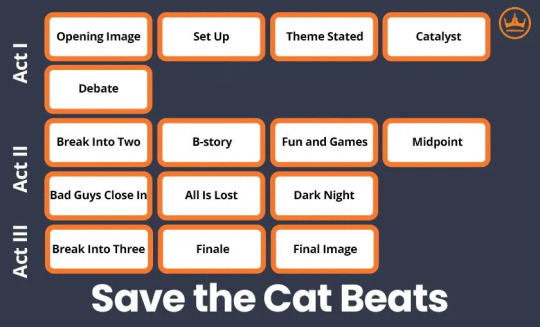
Above are the fifteen beats of Save the Cat and although KB on occasion doesn't hit all fifteen exactly as specified, especially final image as it's continuing, the song and dance is quite similar. Here are examples of The Dark Knight (2008) and Inglourious Basterds (2009), two movies that have inspired Hokazono's work.
Before Chihiro meets Char, we get his opening image of him and his dad forging which is works well as the entire story revolves on the consequences of them creating weapons. We get the set up to his world where he lives with his dad who made famous katanas that wield the power to end a war. The theme is stated, and it's not kept a secret: The katanas they make are weapons made to kill people. Are they willing to carry the burden? In another variation of this question, is Chihiro willing to carry the burdens unintentionally passed down by his father?
The catalyst is his father's murder that catapults him into seeking revenge and recover the katanas.
Now, for the rest of the story, this structure can be applied to the first 18 chapters or even 1-3 chapters at a time which in my opinion, is kind of insane. There's story telling inside the story telling, and these moments are both subtle and grand, signs of a strong and captivating writer. Hollywood would kill for a script like this these days. In order to get you to believe me how prominent these beats are, I'm going to do arc one and Daruma's story. The main story line should be around act one and two right now as of chapter 20, if we want to get down into it, but if anything, this feels like it's moving like a second "movie."
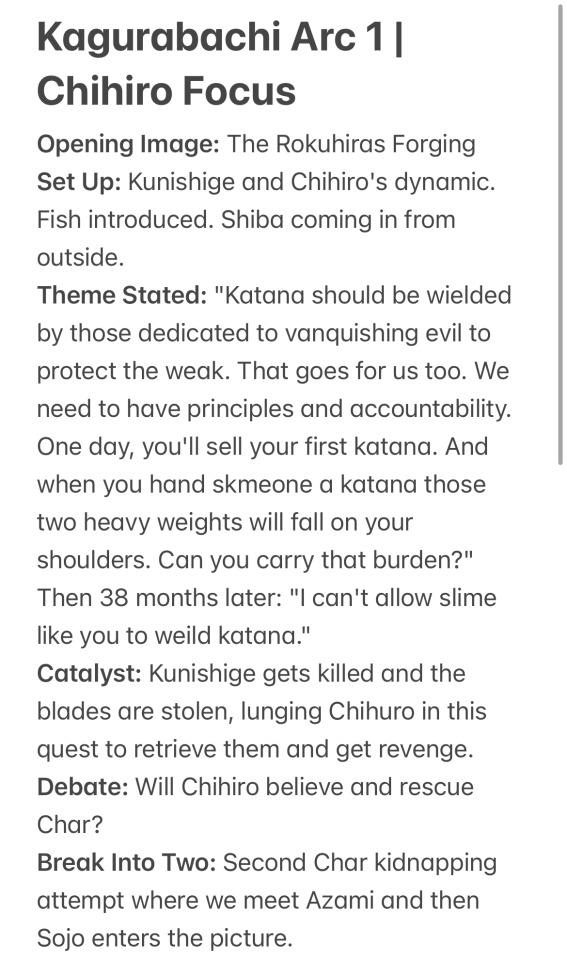
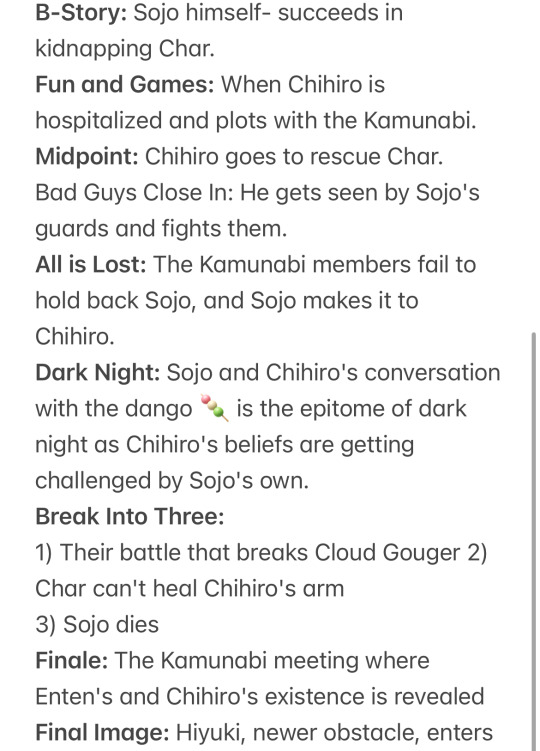
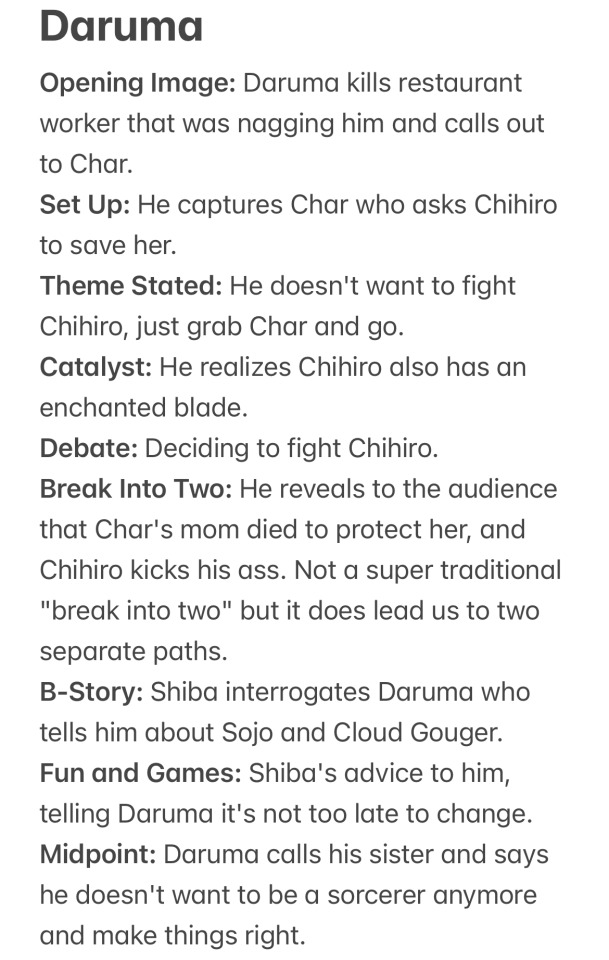

Overall, this structure that comes from Hollywood movies can be identified in multiples parts of Kagurbachi's storytelling. I was going to do beat sheet's for Char and Sojo's stories as well, but I think this is enough of an example of a bigger picture versus smaller. Although other mangas also fall into three act structures, as most story telling does, KB masterfully uses the 15 beats to its advantage. I believe the familiarity of this pace is what hooked oversea audiences, and aside from that, the characters that quickly capture us.
Very quickly, because I don't want to make this about characterization, Chihiro is well written through his past, who he chooses to kill and save, his dialogue that can be surprisingly vulnerable at times, and his cool façade that melts because of how hot he truly runs. He is also straight up a badass. We get handed Char's background in an "all is lost" segment as well as some lore that can present her as a resource for the main cast. We see Azami's phone background photo that's minimum 3+ years old- a government employee with a soft spot for his friends, one who he is still clearly grieving. We get one tiny yet so fucked up bit of Sojo when we see him get a flashback where he's a child and his single dialogue of "I truly love Kunishige Rokuhira," that launched his type of villainy in the maniacal fanboy category. Who does it like that? Nobody but Takeru Hokazono.
Thank you for reading this essay! I do have two other essays drafted, one on Sojo's possible return (I'm a delusional Sojo fan) and just his overall significance and impact as the first villain even if he doesn't return, and on Hiyuki plus servant leadership versus self service.
44 notes
·
View notes
Text
Planning a Series Outline
Hi! This is Hannah and I co-write Englewood After Dark. I was asked recently to explain our outlining process, so here goes.
First, Freytag.
I’m sure at some point we’ve all seen this:

A lot of us, when we’re taught creative writing, are given this and shown it as this is how three act structure is. Freytag’s Pyramid is kinda the basis. But have you ever wondered wtf you’re supposed to include in the rising and falling action?
I certainly used to. And the thing that helped me quantify it was Blake Snyder’s book, Save the Cat. Snyder is a screenwriter, but his work on quantifying the three act structure into what he calls The Beat Sheet applies to all storytelling processes imo.
So, I’m gonna paraphrase his beat sheet and break it all down but this time from the perspective of an Audio Drama creator. This is my process for writing a season outline.
But first!
Know your characters. Know how they begin the story and know how you’d like them to end. Do they start a naive optimist and end a jaded realist? Do they begin stubborn and resistant to change and end stubborn, resistant to change and dead?
Second!
Know what your ending is. This is advice I wish someone had given me when I first started writing. If you don’t know where you’re going, how will you get there?
Third, in the info-graphic, you’ll see the different parts represented by cards on a cork board. Essentially, the more cards, the longer this specific thing should take. So, for example, the Catalyst is normally quite quick, but the Fun and Games often lasts quite a while.
Buckle in! This is gonna be a long one.

Act 1:
Opening Image: This is you showing your main character(s) in inertia. Tell me what the character’s struggles were at the start. This should be mirrored by the Final Image, where (most often) all this is reversed.
Set Up (Theme Stated): The set-up is exactly what it sounds like. Show me the character in their ordinary world, introduce me to their day-to-day. Show me the problem the character has which must be solved by the end. If I have a character whose flaw is inaction, for example, I will show them in the set-up just letting the world wash over them and failing to act. And, as a caveat, give me the Theme. This is the 'truth’ of the story or what your story is really about on a deeper level. 'Would anyone even notice if you just disappeared?’ Another character demands of your main character, and then, through the story, the main character answers the question.
Catalyst: If this doesn’t happen, nothing does. I like to think of it as a diverging path. If the main character didn’t do this, the set-up would continue forever. Nothing would change. No one would grow. It is the choice of change come knocking.
Debate: The character considers their options after being presented with the catalyst. Maybe they could just bury their head in the sand? Can they really do the thing they’re being asked to do? What if they fail?
Break into 2: While the catalyst often happens to the protagonist, here is where they make the choice to commit to this new adventure. They move forward, quite literally, into the story and into a new world.
Act 2:
B Story: Sometimes thought of as the love story, the B story is where the main character comes to meet someone or several someones who help them understand their own Theme. I’m not suggesting that it has to be romantic. In fact, mostly, it’s a platonic love of found family that really makes this beat make sense. The B Story follow us through the rest of the narrative, and they are the ones, often, who incite the events of the Midpoint.
Fun and Games: Also known as the ‘Promise of the Premise’. If you’re writing a haunted story about a ghost-detective sleuthing through the afterlife, then here we see them finding clues and spooking witnesses. If it’s a sci-fi treasure hunt, we’re planet hopping and digging up danger. It’s fun! It’s trailer-able.
MidPoint: I like to think of this as a ‘it all comes crashing down’ moment. During your Fun and Games, things were looking up but suddenly with the MidPoint, things become terrible and impossible again. The stakes are raised, things are getting tough. We have to buckle down and try something new. It cane be really useful to include a ticking clock at this point, pushing the characters to move quickly if they want to succeed.
Bad Guys Close In: The Bad Guys can be quite literal, or in fact just personal demons. I like to do a combination of both. Bad Things are happening: characters are being split up, characters are betrayed, Things are Bad.
All is Lost: Exactly what it sounds like. The character loses everything they thought they gained. They push away their B-Story friends. They’re fired from the case. Someone fully dies. Things are the worst they’ve ever been. Rock Bottom.
Dark Night of the Soul: Your character is staring out of a rainy window, wallowing in their lack. Lamenting this hopeless turn of events. They realise that it’s their flaws that have led them here, and they finally know that. But it’s too late. Or is it? Return of the B-Story! They’re here, they’re ready to give advice, or share information, or do something. The main character must chose: act on this? Or die?
Break into 3: The main character chooses to try again. They’re ready to get the fuck up and try, with their friends. They have a new final goal, and they won’t stop until they accomplish it.
Act 3
This is where we move away from Synder and into territory from another author: Jessica Brody. Snyder likes to just call this ‘Finale’ which is still vague to me, so I like to borrow from Brody here and split the Finale up:
Gathering the Team: The B-Story, the Main Character, and any allies they have amassed come together to finally thwart what needs thwarting.
Executing the Plan: The new Team move on their plan, putting things in motion. Finally accomplishing what felt impossible.
High Tower Surprise: But, alas, there was some further obstacle. Some moment of doubt, some terrible revelation, or slip or obstacle. The hero is down, and they’re maybe done for.
Dig Deep Down: Themes, baby! The Main Character knows what must be done, they muster their strength and go for it. No more time for doubts. Maybe time for a heartfelt flashback though.
Execution of the New Plan: Once more with feeling. The character pulls themselves together and acts. They finally manage to do what they set out to do. They win, or lose. Whichever way it goes, it is final, as they gave everything to achieve it.
Final Image: The opposite of your Opening Image, showing how the main character has changed.
That was a lot. But, essentially, once I’ve added a quick paragraph for each of these cards, I have a rough outline of my entire plot.
I flesh this out by deciding then how many episodes I will dedicate to each Act. From there, I write little episode summaries, fleshing out details and filling in the cracks in my more generalised outline. For those summaries, I think about where we are in the overall plot structure, and provide the details.
If you’d like to see how I lay this out, I’ll include our plan for our vignette Schrödinger’s Pledge below. It's not a series, but it should give examples of each step.
Schrödinger's Pledge Spoilers are coming!
Opening image Helen surfaces from under the water of the frat house pool and a sister calls out that she thought she’d drowned. Helen alludes to being a good swimmer/ being able to hold her breath. Helen, still dripping wet, is led from the rush party by Jared towards the Cypress Phone Booth. He asks if she’s scared. Helen clearly thinks he’s an asshole.
Set Up/ Theme Stated - You can’t live in the past. We meet Payton stood outside of the Phone Booth waiting for Muffy to finish up. She tells Jared to fuck off. Jared says he’s gonna wait to take Muffy back and Payton says no thanks gtfo. Jared leaves. Helen and Payton have a tense back and forth where they talk around the subject of how they became enemies.
Catalyst Muffy steps out of the booth and is hysterical. Payton consoles her sorta. Set up the rules of the booth.
Debate Payton puts Helen in the booth.
Break into 2 Helen gets in the booth and picks up the phone.
B Story/ Fun and Games Helen connects through the phone to who she thinks is her mother. She has an emotional conversation with her ‘mother’ for a while. She wants to understand her mothers drowning; did she really kill herself as Helen suspects, or was it as accident as it was ruled?
Midpoint Helen realises this isn’t her mother and that she’s been in the phone booth for more than the allotted time.
Bad Guys Close in Dead!Helen tells her that there is no living through the phone booth for her - a legacy must be given. Time has no meaning to the dead.
All is Lost Helen tries to open the door, Payton gloats about how she was prepared to lock her in, but didn’t need to.
Dark Night of the Soul The booth begins to fill with water and Helen wonders if it is all over for her.
Break into 3 Helen holds her breath and plays dead. Not for the first time with Payton.
Finale: Payton opens the booth to check on her plan, Helen grabs her and pulls her inside, slamming the door. Payton screeches and Helen picks up the phone and makes a collect call to the after life, opening the connection and locking them both inside together. Helen hands Payton the phone and Payton succumbs to the horror of the booth. She hears her grandmother admonishing her for being an embarrassment and begins to smash her own face into the window of the phone booth. Much to Helen’s horror.
Final Image: Helen crawls out once Payton is dead and Jared is waiting to ask her if she’s going to ‘babble’ about all of this.
6 notes
·
View notes
Text
i've probably never had an original experience in my life so screaming this @ the void that is tumblr!! i love love love having a paracosm that's mainly about actors because when i want to explore a very specific trope or plot line that doesn't warrant the brain space of an entirely new world with entirely new characters i in fact do not need an entirely new world with entirely new characters. i can say the film's story sucks and stop worrying about making something dreamt up solely for personal pleasure follow blake snyder's save the cat beat sheet. i can take off the mental pressure of coming up with the perfect character names because come on people there are still protagonists in greenlit shows in the year 2024 called john. i can imagine the silly goofy bloopers that would roll over the end credits. sometimes i do not love the fact i can't concentrate on important real life responsibilities because i'm thinking up a sick a24 poster for the imaginary film my imaginary friends starred in but hey. we make sacrifices
2 notes
·
View notes
Note
Heyyy! I saw your post about thinking about writing a full length novel. For one, super excited for you. It is so rewarding to write a novel and is incredibly worth it if you have an idea that is enough for a novel. For two, I think I may be able to help. (This may be long because I’m about to nerd out a little. I’m not sure what genre you’re writing in, so all of this is just bare-bone thoughts. If you want me to elaborate more on anything, I can and will!)
Here are my credentials: I’ve been writing since elementary school (about 7) and have written 23 short stories, 7 full-length novels, and am currently working on my 8th, which will be the first book in a series. I write primarily coming of age novels, high-stakes fantasy, and cozy, low-stakes romantic fantasy novels, but I’ve dabbled in other genres like mystery, thriller, horror, sci-fi, and contemporary/romance.
Anyhow, my advice for outlining is to start with the basic three-act structure, especially if you’ve never used an actual outlining structure before. The three-act structure is essentially just beginning, middle, and end. Jessica Brody has a beat sheet that takes you through all of the “beats” you need to hit in order to create a well-rounded story. It works pretty great. Her book is called Save the Cat: Writes a Novel, and it’s based on the book Save the Cat by Blake Snyder, which focuses on screenwriting rather than novel writing. She actually has a free copy of her beat sheet on her website with instructions on how to use it. Something that I think is really important to remember when it comes to using a beat sheet is that it is more like a guide or suggestions, not something that you have to strictly follow. Everyone’s writing process is different, so use what works for you and ignore the rest. If you want, I can send another message detailing what my personal outlining process is. I don’t use the three-act structure because it doesn’t really work well for me, but it works for A LOT of people, so it’s worth trying. Instead, I created my own outline using a four-act structure with some parts of other outlines, which works for me (some people call this a Franken-outline or a Frankenstein outline because it’s made up of different outline methods).
As for length, it depends on what you’re talking about, like the length of time in which it takes to write a novel or the length of the book (sorry, I can’t tell which one you meant). For me, I usually work on several projects at once, but the outlining process typically takes a few weeks, maybe less if I have a concrete idea or maybe more if I have a lot of plot development/world building to do (such as the case for my current project). For actually drafting, it takes about 2-3 months for me to write a novel that is between 60-100k. I recommend figuring out a writing schedule that works for you whether that be a daily goal, weekly goal, or simply writing when you feel like it. I’m a college student, so I try to have a strict but forgiving writing schedule that includes a daily or weekly goal of 2-5k words, which depends on how busy I am. That may not be the case for you, and that’s okay. The length of your novel depends on the genre you’re writing in. I recommend looking up the estimate word count or page count for the genre(s) you wish to write in to get a rough idea on how long your book should be (ex: romance is typically 50-90k and fantasy is typically 50-150k), but your word count can be more or less than that. Please remember that your novel does not need to fit into these word counts if it doesn’t work for your project. Something I think a lot of people get stuck on is meeting a specific word count. Please don’t do this T-T. You may go into a project thinking it’s going to be a full-length novel (50–80k) and it turns out to be a novella (17.5–40k), which is fine. Don’t try to make your story what it’s not. Allow it to be what it is because, if it’s written well, it won’t matter if it’s 5k words or 50k words.
I’d also like to touch on character creation a little. I think having character sheet(s) for your main character(s) and the antagonist/villain(s), is important, but I also think it is important to not get caught up on the tiny details that are not really needed. If something like your character’s favorite color or favorite food comes up in the writing/drafting stage, add it to your character sheet so you can remember it, but don’t fill out those 100 prompt character sheets because, in my opinion, they’re a waste of time. I’m trying not to make this too long (it’s already long asf, I’m sorry T-T), so if you’d like me to go into detail on what I think you should know about your character(s), or what you should put in your character sheet, I would be 1000% willing to elaborate. I also have a character sheet that I made and use for every project and I would be willing to share it if you think it would be of help to you!
Also, just to touch on drafting a bit because that’s something I find people get stuck on, remember that the first draft does not need to be perfect. My sixth book took 5 drafts and 8 edits before it felt right because there was a lot of detail and things that I either came up with after the first draft was completed, changed, or altered.
Here are some other fun things that I do when I am planning, outlining, and drafting: Pinterest boards!! I make a Pinterest board with sections. It is so helpful to get a feel of what the aesthetic of your book is, what your characters look like, and what their aesthetics are, and can help tremendously with world-building if you need to (I can totally give you advice on that too if you need it!). Music playlists are super great too. Sometimes I just make a full novel playlist, and sometimes I also make playlists for certain important characters. I listen to these playlists while I’m world-building, outlining, and drafting because it helps me get in the mindset of the novel. It can also be helpful if you're writing multiple POVs. Another thing I do is attach certain songs to certain scenes of my novel, which is super fun (ex: a high-stakes action scene could have a song like Run Boy Run by Woodkid attached to it). Notion is probably the greatest app ever created. I use it for everything, including world-building, character sheets, plotting/outlining, writing schedules, and writing/word count tracking which is super helpful if you’re trying to stick to a specific schedule. It’s literally amazing because you have everything in one place. You can also write your novel in Notion (I know a few people who do), but, to be honest, I don’t recommend that.
I’m sorry that this is so long, but I’m super excited for you. Writing a novel is literally the most exciting and rewarding thing ever. No matter how many I write, I never get tired of it. I hope that it’s as fun for you as it is for me and I hope that the information I’ve provided will be helpful! Again, if you need me to elaborate on anything, I am more than willing to because, if you haven’t noticed, I love to talk about this.
Sharing in case there’s anyone else out there that needs this as well!!
Oh. My. Goodness does this make me feel more confident.
I’d love some more about character sheets.
One thing I’m really struggling on is making the antagonist likable but not… too likable. But maybe half of the fun is maybe having a split decision here.
Another thing: I’m so freaked out about making my main girl too bland. Cause I’ve read so many where they have no personality and then there are some where there’s too much personality and I get way too mad at her. But I think I need to take a breath and let things flow the way they’re meant to.
One important question: how much dialogue to you is too much? I feel like I’m a big dialogue type author which is a blessing and a curse. Like you can reveal things about people purely on the things they say and I feel like that’s better than spelling out blatant facts to the reader
I’m sure most of my questions are just dependent on the author’s preference but still
Any thoughts you have about ANYTHING, I will HAPPILY take into consideration
6 notes
·
View notes
Note
Hewwo~ I love the comics you guys make! Can I ask about what your writing process is like? Do you follow some sort of 3-act structure template, or have some other fun tools? Where do you get your ideas from? Sorry if that's a lot to ask! I want to be a strong writer like you guys!
Hello there! :> thank you for the kind words!!
If I had to describe my writing process it would be working "general to specific". So I would have a general idea for a story, work out the big events, then flesh out the details down to dialogue and character acting (I like to have that figured out in the script early so once I sketch/thumbnail the comic I'm not mentally overworked).
Elevator pitch -> Outline -> Story Breakdown -> Script
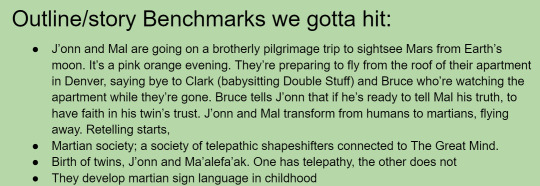
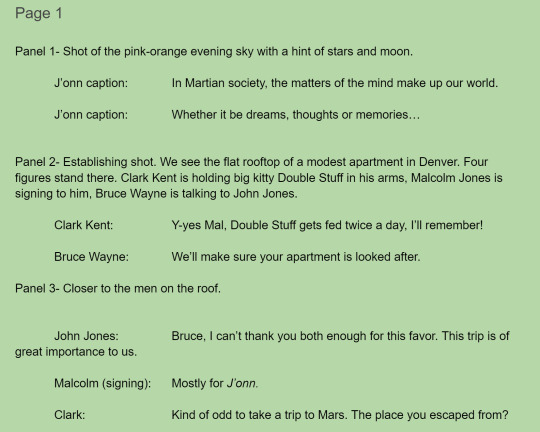
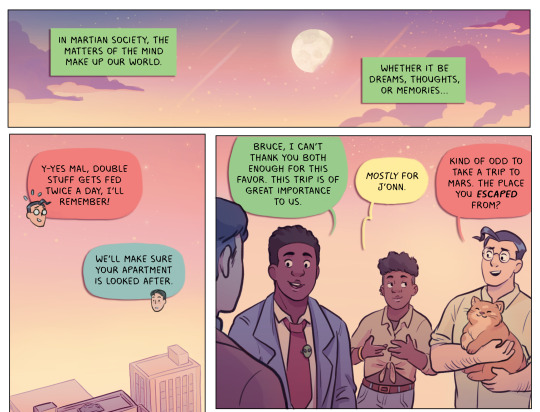
Throughout the process I'm always keeping in mind what the theme of the story is, making sure it's not lost in the process. The 3 act structure comes naturally from feeling the story out, but it's good to revisit sometimes if you feel like your story is missing a beat or needs rearranging. I usually check out Blake Snyder's beat sheet when I feel something's lacking but I don't treat it like strict rules to follow- more like a guideline.
For where I get my ideas from, lately it's a mix of lived experience that I want to see more of in fiction or a twist on existing stories. "Princess Kaguya x Little Prince but about a trans masc Indonesian boy going through culture shock" or "Martian Manhunter but his evil twin brother is misunderstood and not evil". Stuff that would be fun to write and gets me excited just thinking about them.
I hope that was helpful! And good luck on your writing!!
#askjesncin#writing advice#my script is green to prevent eye strain#it's not cuz i love martian manhunter so much however-
18 notes
·
View notes
Text
Writing Notes: Blake Snyder's Beat Sheet
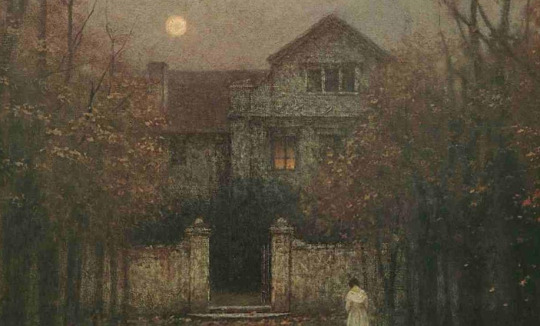
A summary of Blake Snyder's Plot Method
ACT ONE (Thesis)
1. Opening Image (1) - set tone, mood & style; give “before” snapshot of hero
2. Theme Stated (5)- declaration of theme, argument or story purpose (by minor to main character)
3. Set-up (1-10) - introduce hero’s quirks; how & why they need to change
4. Catalyst (12) - bad news that knocks down set-up, but ultimately leads the hero to happiness
5. Debate (12-25) - hero questions their ability to proceed
ACT TWO (Antithesis)
6. Break into Two (25) - hero (through their own decision) moves into the antithetical world
7. B Story (30) - break from main story; often a “love” story; meet new characters antithetical to earlier ones
8. Fun and Games (30-55) - provides the promise of the premise; movie trailer moments; whatever’s cool
9. Midpoint (55) - fun and games over; hero reaches false peak or false collapse; changes dynamic; raises stakes
10. Bad Guys Close In (55-75) - bad guys regroup; internal dissent in hero’s team; hero isolated and headed for fall
11. All Is Lost (75) - false defeat (that feels real); “whiff of death” (often of mentor); end of old way
12. Dark Night of the Soul (75-85) - darkness before the dawn; hero feels they’re beaten and forsaken
13. Break into Three (85) - internal B story provides solution to A story
ACT THREE (Synthesis)
14. Finale (85-110) - triumph for hero; bad guys dispatched (in ascending order); hero changes world
15. Final Image (110) - opposite of opening image; proof of real change
Source ⚜ More: Notes & References ⚜ Plot ⚜ Character ⚜ Worldbuilding 10 Story Genres (& their Elements) ⚜ The Transformation Test
#writing notes#plot#writeblr#fiction#on writing#writing tips#writing advice#writers on tumblr#dark academia#spilled ink#writing reference#literature#writing prompt#creative writing#writing inspiration#writing ideas#writing inspo#light academia#novel#booklr#bookblr#story#jakub schikaneder#writing resources
75 notes
·
View notes
Text
Struggling to Focus on Plot vs Everything
Anonymous asked: I'm currently outlining (whilst still figuring out my plot and everything), but I keep getting sidetracked. My brain is trying to plant seeds to help me figure out the overall story, but it's distracting me from getting the main story line plotted out because instead I'm trying to come up with every possible scenario for why things happen. This method is exhausting, though, and I'd rather have a solid story line first, then flesh it out from there. Ultimately, I feel like I need to figure out my story's timeline and the main events, because I want that all sorted before I tackle how the characters experience it. It's just really overwhelming and when I try to pluck out the big pieces, they crumble into smaller pieces.
[Ask, and subsequent ask, edited for length and content]
So, if I understand correctly, it seems like part of you just wants to get down the actual plot of the story, but when you try, you end up delving into all these deeper background details?
What I'm thinking is this: if you're able to, I would start by doing what I think of as a "holistic summary" of your story... sort of like a brain dump but in general chronological order from beginning to end. It doesn't have to be perfect... you can backtrack, jump around a little, and go on tangents as needed. The point is to just get down as much of the story as you know... and as much as your brain will want to flesh out in real time... just to get it out of your head.
Sometimes, just getting it all out of your head on paper in one single container can help free up your brain to focus on the backbone of your story... the actual framework all of those details need to adhere to.
Another thing that might help, if you haven't done this already, is to look for a story structure template to help you tease out the story. There are loads of them out there from Save the Cat Writes a Novel! to Larry Brooks Story Structure, Three-Act Story Structure, the Snowflake Method, The Hero's Journey, Blake Snyder's Beat Sheet, Derek Murphy's 24 Chapter Outline, Gwen Hayes' Romancing the Beat, Shawn Coyne's Story Grid, The Seven Point Plot Structure, Dan Harmon's Story Circle, The Five-Act Structure, James Scott Bell's A Disturbance and Two Doorways, Kishōtenketsu Structure, Story Spine, and a bajillion others... The key to using a story structure template is to know it doesn't have to be followed exactly. They're not there as molds to cram your story into... they're more like "suggested itineraries" for a road trip. This is an ideal route with some popular stops along the way, but you may wish to alter the route slightly or make some different stops. Many writers actually use bits and pieces of different templates to suit their needs or the needs of their story.
Sometimes, just choosing a random template to tease out your main plot can be enough to help you see exactly what the main plot is, which makes all the other stuff fall into its proper place as character development, back story, and world building.
I hope this helps!
•••••••••••••••••••••••••••••••••
I’ve been writing seriously for over 30 years and love to share what I’ve learned. Have a writing question? My inbox is always open!
♦ Questions that violate my ask policies will be deleted! ♦ Please see my master list of top posts before asking ♦ Learn more about WQA here
47 notes
·
View notes
Note
when you are writing a fic do you have most of it planned out beforehand or do you kind of make it up as you go along?
In the past, I've mainly identified as a plotter.
My typical approach to a story was to use Google sheets and write out mini summaries of each chapter. I used Blake Snyder’s story beats, the 27 chapter method, Dan Wells’ seven point story structure, the Highway and Service Road method from Jane Cleland’s book, “Mastering Plot Twists” and everything in between.
However, after composing the blueprint for a story I’d often be bored and struggle to write the actual novel. Knowing what happened next killed the vibe. Another issue that I saw in my writing was that my character development and their growth cycles sometimes felt stilted and forced. Whether or not I could capture the essence of a character was a roulette of hit or miss.
Because of that, I approached TPATL in a different manner. I felt like I finally knew structure well enough that I could pull off a character driven story - I’d attempted it before, around 2018, and it ended disastrously. TPATL exists primarily because Lloyd was the perfect character with enough conflict and personality drama to keep pushing the story forward. The tension between him making a conscious choice to be good, when his natural instinct is to be bad, and the effect that Princess has on him in suppressing a lot of those urges, makes a character driven story about him much easier to develop.
I do still use plotting and structure to set overarching plot goals, but the finer details of the story are left open for spontaneous creation. For example, I knew I wanted to write the scene where the stalker enters Lloyd’s backyard and attacks Princess by the swimming pool from the start. The identity of the stalker though, was up for debate until this morning when I officially decided who it was. I really enjoyed writing this way. Using structure when I needed it to figure out where I was going and letting the rest unfurl organically was fun and frustrating. There have been several points where I’d painted myself into a corner and didn’t know how to get out. But something always came together in the end - albeit to varying degrees of success and gracefulness. (Ahem… subplot with Lloyd and Sheriff Holbrook, I’m looking at you. That ended up taking so long that I just decided to cut it short. I deleted a bunch of content that would’ve rounded it out, and yes, I do mean deleted as in permanently deleting those chapters from my hard drive/cloud.)
Writing TPATL as a character driven story has enriched my ability to think on my feet, solve plot holes as they crop up, and write characters with richer internal conflicts. Even Princess has become more complex to the point where she’s less of a reader insert and more of a real character. Her behavior is fairly consistent and there’s an identifiable personality with its own unique thought patterns.
I even dove into Lloyd’s childhood with the Idaho subplot. Unfortunately, this had the side effect of turning the story into a massive plot sprawl. I needed to wrap things up and tie off loose ends to get back to the main storyline. In hindsight, had I planned this out architect style, the narrative would have flowed smoother, culminating in a more logical conclusion.
As I approach the climax of TPATL, I’ve found myself grappling with a number of challenges because of my lack of planning. At this point, the whole thing is a maze. It’s irritating, especially for someone averse to revisiting their past work, but it’s forced me to think creatively and find innovative solutions when I’ve written myself into a corner.
So, to answer your question: usually I’m a plotter. My natural inclination is towards plotting, but TPATL has been an exercise in flying by the seat of my pants. I’d say that this current story has been 85% improvised and 15% planned.
#penguin replies#penguin comments#writing process#alice comments#alice rambles#writing stuff#creative writing#how i write#alice talks#TPATL writing process
3 notes
·
View notes
Text
3-act structure: Save the Cat! structure
The Save The Cat Beat Sheet helps authors create a plot structure using fifteen plot points. It is a simple novel-writing template that can help outline a novel or film script from any genre.

A brief overview of each of its 15 steps
Opening Image (1% of the script): This is the first impression of what kind of story the audience is about to see. It's a snapshot of the main character's problem before the adventure begins.
Theme Stated (5%): The theme of the story is subtly suggested, often in a conversation.
Set-Up (1-10%): This section provides more information about the hero's current life and what is missing from it.
Catalyst (10%): A problem disrupts the hero's life, also known as the “call to adventure”.
Debate (10-20%): The hero doubts the journey they must undertake. It's a last chance for the hero to say “No”.
Break into Two (20%): The hero makes the decision and enters a new world or way of life.
B Story (22%): A secondary story begins, often involving a love interest or a sidekick, that will weave in and out of the main story. It often carries the theme of the story.
Fun and Games (20-50%): This is often where most of the trailer moments occur. The hero explores a new world, and the audience is entertained.
Midpoint (50%): A moment of either success or failure that changes the hero's journey in a meaningful way.
Bad Guys Close In (50-75%): If the midpoint is high, things get bad here. If the midpoint was low, things started to look up.
All is Lost (75%): The lowest point for the hero. The journey seems impossible to complete, and the hero feels defeated.
Dark Night of the Soul (75-80%): The hero hits rock bottom, wallowing in hopelessness. The hero learns the theme stated back at the beginning.
Break into Three (80%): The hero finds inspiration, often from the B Story, and decides it's time to fight.
Finale (80-99%): The hero confronts the antagonist or whatever stands in their way. The lessons learned in Act Two are put into action.
Final Image (99-100%): A reflection of the opening image, showing how the hero's world and character have changed.

0 notes
Text
Hoja de los tiempos
Blake Snyder
La "Hoja de Tiempos" (o "Beat Sheet") de Blake Snyder es una herramienta utilizada en la escritura de guiones y desarrollo de historias. Es un esquema que desglosa los puntos clave o "beats" de una narrativa, guiando a los escritores en la estructuración de sus historias de manera efectiva y coherente. Esta herramienta se popularizó a través del libro de Snyder, "Save the Cat!".
La Hoja de Tiempos de Blake Snyder contiene 15 beats esenciales que se dividen en tres actos.
Utilizar la Hoja de Tiempos de Blake Snyder para crear una obra de títeres puede ayudarte a estructurar tu narrativa de manera efectiva, asegurando que mantienes la atención del público y desarrollas una historia coherente y atractiva. Aquí hay un desglose de cómo puedes aplicar cada beat a una obra de títeres:
Acto 1:
Opening Image (Imagen Inicial): Escena inicial que introduce el escenario y el tono de la obra. Puede ser una imagen del entorno donde se desarrollará la historia.
Theme Stated (Tema Expresado): Un personaje, tal vez un títere sabio, puede hacer una declaración o pregunta que refleja el tema central de la obra.
Set-up (Preparación): Introduce a los personajes principales (títeres), sus relaciones, y el mundo en el que viven. Muestra sus rutinas diarias y establece el contexto.
Catalyst (Catalizador): Un evento que cambia la situación normal de los personajes, iniciando la acción principal de la historia. Puede ser la llegada de un nuevo personaje o una noticia inesperada.
Debate (Debate): Los personajes discuten o reflexionan sobre el cambio que deben enfrentar. Aquí pueden mostrar sus dudas o miedos.
Acto 2:
Break into Two (Paso al Acto Dos): Los personajes deciden embarcarse en una aventura o tomar acción para resolver el problema presentado por el catalizador.
B Story (Historia B): Introduce una subtrama que puede involucrar a personajes secundarios. Esta historia complementa y contrasta con la trama principal.
Fun and Games (Diversión y Juegos): Presenta escenas divertidas y entretenidas que exploran el concepto central de la historia. Aquí puedes incluir situaciones cómicas o emocionantes con los títeres.
Midpoint (Punto Medio): Un evento crucial que cambia la dirección de la historia. Puede ser una gran victoria o un revés significativo para los personajes.
Bad Guys Close In (Los Malos Se Acercan): Aumenta la tensión con la llegada de nuevos obstáculos o villanos que complican la misión de los personajes.
All Is Lost (Todo Está Perdido): El momento más bajo para los personajes, donde todo parece perdido y el objetivo inalcanzable.
Dark Night of the Soul (Noche Oscura del Alma): Los personajes reflexionan sobre su situación y encuentran la determinación para seguir adelante. Es un momento emocionalmente profundo.
Acto 3:
Break into Three (Paso al Acto Tres): Los personajes encuentran una solución y deciden tomar una acción decisiva para resolver el conflicto.
Finale (Finale): La confrontación final y resolución de la historia. Los personajes enfrentan el conflicto principal y lo resuelven.
Final Image (Imagen Final): Una imagen o escena final que muestra el resultado de la historia y el cambio en los personajes. Refleja el arco narrativo completado.
Ahora que el "Viaje del héroe" nos ha ayudado, en clases anteriores, a encontrar las motivaciones del protagonista, voy pensando cómo sería el proceso para utilizar "La hoja de los tiempos" para estructurar la dramaturgia general de nuestra obra de títeres:
Esquema Inicial: Escribe un esquema básico de tu historia siguiendo los 15 beats. Esto te dará una visión general de cómo se desarrollará la trama.
Personajes y Escenario: Desarrolla los personajes y el escenario donde ocurrirá la historia. Piensa en cómo cada beat afecta a los personajes y el entorno.
Diálogos y Acciones: Escribe los diálogos y acciones de los títeres para cada beat. Asegúrate de que cada escena avance la trama y desarrolle los personajes.
Ensayos y Ajustes: Realiza ensayos con los títeres para ver cómo funciona la historia en acción. Ajusta el guion y las escenas según sea necesario para mejorar el flujo y la claridad.
Elementos Visuales y Musicales: Considera cómo los elementos visuales y musicales pueden reforzar cada beat. La música y los efectos visuales pueden ayudar a enfatizar los momentos clave y mantener el interés del público.
Esta estructura ayuda a los escritores a mantener un ritmo narrativo consistente y a asegurar que cada parte de la historia tenga un propósito y una dirección clara. Tomando de referencia esta estructura, podemos crear una obra de títeres bien estructurada y emocionante que mantendrá a tu audiencia entretenida y comprometida con la historia.

0 notes